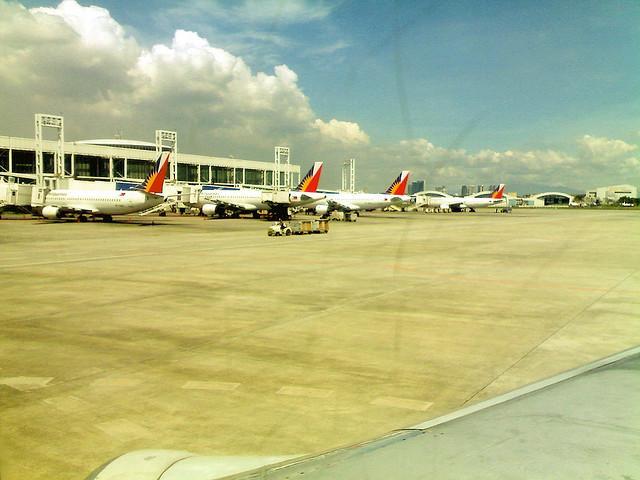
Ninoy Aquino International Airport
As an archipelago composed of more than 7,000 islands, the Philippines offer various modes of public transportation to foreign and local travelers alike. Filipinos have creative and practical ways of going from one place to another and these means of transportation are some sort of tourist attractions in themselves. Whether it is for island hopping or just for a tour around the city, you have a lot of options to choose from.
1. Airplane
There are several international and domestic airports located in major cities and provinces around the country. Traveling by plane is the fastest and most convenient means of inter-island transportation. Although it is perceived that airplane fares are a tad expensive, they are actually much cheaper now, thanks to different discounts and promotions given by airplane companies. For example, you can avail discounts if you book your flight early or if you buy tickets in group.
2. Ferry/Boat
If you want to ride your own vehicle or take a provincial bus for inter-island travel, the ferry is the most appropriate choice for you. Ferries can take vehicles and huge luggage and they move from one major island to another (Luzon, Visayas, Mindanao). Boats, on the other hand, are used for going to smaller islands. If you have a long list of islands to visit in the Philippines, then you will have to travel by boat. Both of these forms of transport let you relish the beauty of the seas surrounding the country.
3. Banca/Water-taxi
This is smaller than a boat and can seat only a maximum of ten people. If you want to go to a specific location that is not traversed by ferries or boats, you can rent a banca. It is paid by the hour and serves as your water-taxi for the day. Snorkeling and island hopping are not very promising without a banca.
4. MRT/LRT
Metro Rail Transit (MRT) and Light Rail Transit (LRT) provide direct routes around Metro Manila. The MRT traverses the Epifanio Delos Santos Avenue or EDSA while the LRT goes from Baclaran to Monumento. During the late months of 2011, the merging of MRT and LRT started operations, thus providing commuters a more convenient way of moving about Metro Manila.
5. Bus
There are a lot of city buses available if you want to avoid the congestion of passengers in the MRT and LRT. Also, provincial buses offer rides to different rural areas if you are on a tight budget. Most of them are air-conditioned and have a TV and DVD player for the passengers’ comfort. Some provincial bus companies also provide WiFi at their terminals to occupy commuters while waiting for their departure.
6. FX/Taxi
The term “FX” came from the Isuzu Tamaraw FX, the first all-purpose utility vehicle to be used in public transport. Consider it as a carpool ride among strangers. Alternatively, a taxi is just hired by one person per ride, typically an upperclassman who is working in a corporation but would rather not drive. An FX usually has a terminal to wait for passengers while a taxi just picks up commuters along the way.
7. Jeepney
This is a unique Filipino icon. The word jeep was coined from GP or General Purpose, a remnant vehicle from World War II. Filipinos made the jeepney longer and more artistic, with paintings on its body, and colorful flaglets and small figurines on the hood. Nowadays, jeepneys are the most common form of public transport and you can find them everywhere – in the cities and at rural areas.
8. Tricycle
Playfully referred to as the “poor man’s cab,” a tricycle takes short-distance routes around towns and subdivisions. It is a motorcycle with a sidecar and can seat up to six people, including the driver. It is also hired to take merchandise to and from the market.
9. Pedicab
Most frequently called as “Padyak”, a pedicab is a simpler form of a tricycle, with a passenger cab attached to a bike instead of a motorcycle. It is only available for short rides and can seat a maximum of three people, plus the driver. You can find them on some side streets and subdivisions where tricycles are not allowed to enter. This vehicle is very eco-friendly because it just uses sheer human force to operate.
10. Calesa
Another environment-friendly vehicle is the calesa, a horse-drawn carriage which can be found in old cities like Vigan, Itramuros, and Binondo. It is used to preserve the old-fashioned vibe of these cities, thus allowing tourists to experience what it is like to travel before the reign of automobiles.
11. Habal-habal/Motor-taxi
Looking for an exciting mountain adventure? Here’s habal-habal for you! Most common in mountainous regions, a habal-habal is an ordinary motorcycle with an extended seat and extra shock absorber in its rear. It can seat up to seven people, plus their luggage. This is the most suitable way of transportation for rough terrains and roads that are not passable using four-wheeled vehicles.
12. Carabao
India has its elephant and the Middle East has its camel. Well, the Philippines has its carabao – the country’s national animal. If you want to visit vast rice fields and vegetable farms in person, then riding a carabao will surely add to your experience points!
With these various modes of public transportation, the whole Philippines is within your grasp. May it be a mountain, a beach, or a city you want to explore, these vehicles are available for your own convenience and budget.










